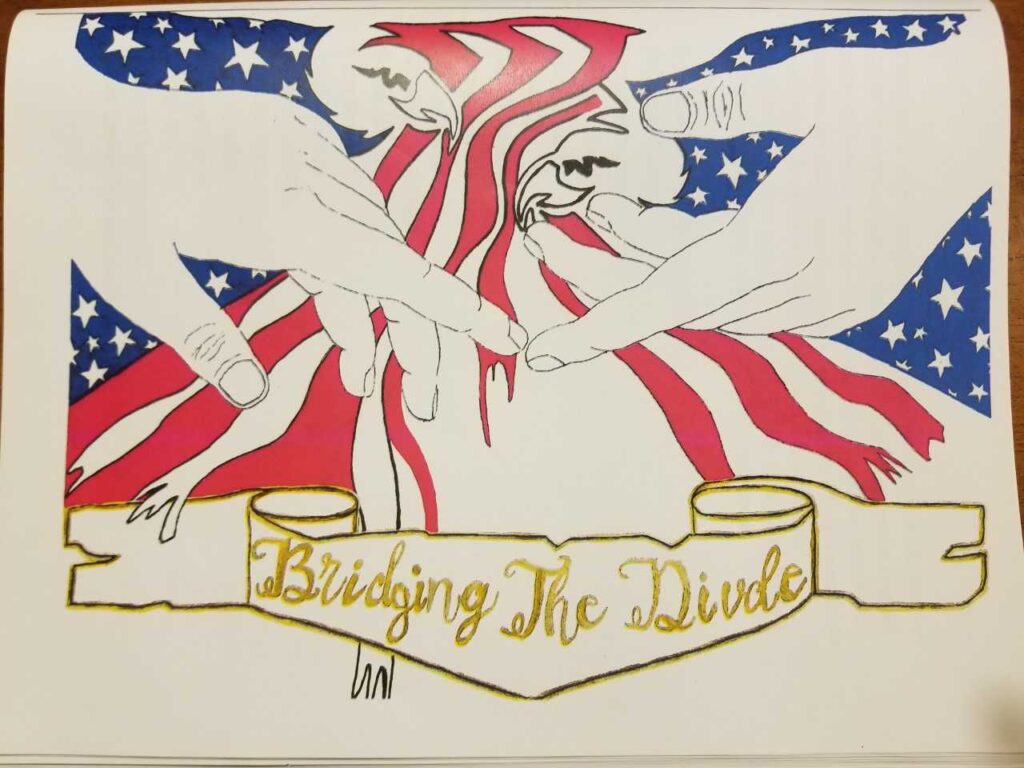
In fall of 2020, prominent filmmaker Lynn Novick went to her alma mater, exclusive New York City prep school Horace Mann, to showcase her Emmy-nominated documentary series, College Behind Bars. A year later, the documentary—showcasing the Bard College Prison Initiative, which brought in-person learning and education to prison—inspired Horace Mann senior Simon Schackner to create something that appears to have never been done before: a class simultaneously taught to 11 students at his high school and six students at a minimum-security women’s prison in Maine.
“I was just amazed by watching the documentary and realized that I feel like my peers and I kind of take our education for granted,” Schackner told Ms.
Although classes between incarcerated people and traditional college students have occurred in the United States, such as Tufts’s Inside/Out program, it seems nothing like it has been done at the high school level, creating a potential new movement in education.
About the Class
The class, entitled “Bridging the Divide,” started in September of 2021 and ended in January 2022. Meeting on Zoom three times per week, the class was taught collaboratively between Rebecca Bahr, a teacher from Horace Mann, and Abbie Embry-Turner from the Southern Maine Women’s Reentry Center.
Bahr and Embry-Turner both say the class functioned as a typical Zoom class—all students listened and participated in discussions about their assigned readings. “Bridging the Divide” included readings in contemporary American fiction, nonfiction and poetry, in an attempt to answer the question: What is the American dream, and what is the American reality? Several guest authors visited the class, including Phuc Tran, Silas Hagerty, Arisa White and Rodney Spivey-Jones.
The fact that somebody in a privileged position like that could think that I have something to offer is a new thing. And I want that to be known—that we have a lot to offer. Lived experience is worth so much.
Gwen Wellman, a student in a Maine correctional facility
“Bridging the Divide” isn’t being offered this semester, but Bahr and Embry-Turner’s new class called “Monstrous Humans, Humane Monsters” will be attended by many of the same students, as well as some new ones from both the prison and the high school.
Partnerships and the Creation of “Bridging the Divide”
Although the classes have become great successes, with too many students wanting to be a part of the classes than are able to join, creating “Bridging the Divide” in the first place wasn’t easy.
“Ironically, Horace Mann was sort of skeptical, because this was still pre-COVID, about the prospects of anything online,” Schackner said. Luckily, the school was open to his idea, and later, when Schackner applied for the Alexander Capulluto Award from Horace Mann, an award that seeks to encourage public service, he was awarded $2,500 to assist in creating the course. This funding allowed all of the students the ability to have copies and own all their books. The rest of the money will help bolster the correctional facility’s library.
Schackner also reached out to Big Picture Educational—a small educational organization that works with filmmakers to bring film and media content to schools, communities and universities, who also partnered with College Behind Bars. Through Big Picture, Schackner was able to work with and discuss the creation of “Bridging the Divide” with, among other people, Lynn Novick.
Kim Birbrower, founding partner of Big Picture Educational, said they were thrilled to help. “We often get feedback from teachers and students about the impact our films have had when they’ve watched them. …[‘Bridging the Divide’] is a really great example of how one student took that inspiration and put it into action.”
Bahr and Embry-Turner spent countless hours crafting a syllabus and worked with Washington Community College and University of Maine-Augusta to provide college credits for the class to the incarcerated women who took the class.
“I think there are a lot of misconceptions about why our students are here, or why they may or may not deserve this type of opportunity,” said Amanda Nowak, director of prison education partnership at the University of Maine at Augusta. “But I think people don’t realize all of the systemic barriers and challenges that our students have faced that brought them to this point. We want to make sure all of the members of our community have the same educational rights because education can greatly reduce the challenges that people end up facing down the road. From a restorative standpoint, we believe education has the power to transform lives and transform communities and so it will always be worth investing in our students.”
Eventually, Commissioner Randall Liberty in the Department of Corrections in Maine, a leader in implementing policies and programs to reduce recidivism, signed off on the course: “When this proposal came to me, I didn’t hesitate. … Any time that I can expose the people that are under my care to higher education to broader thinking to expand their horizons … is very beneficial. … Folks who are incarcerated should not be considered throwaways. They are worth investing in and our communities will be stronger as a result of these programmatic efforts.”
Local Maine businesses such as Bridgton Books and Reny’s also were involved in the process and donated books and supplies for the class.
Intentionality Within the Classroom
Although there were significant differences between the high school students at Horace Mann, all of whom are seniors, and the incarcerated women, most of whom are mothers whose average age is 35, Bahr and Embry-Turner are determined in each class not to focus on the differences between those who are incarcerated and those who are free. Embry-Turner told Ms. the classes are “really a celebration of intellectual capabilities in the class. … We’re all Americans in one way or another, and looking at what it means what that means to us individually and collectively and where you’re coming from [is] the least important.”
The students have felt and understood this intention. “It wasn’t learning about each other. It was learning in tandem,” said Gwen Wellman, an incarcerated student who was in “Bridging the Divide” and is currently taking “Monstrous Humans, Humane Monsters.” Wellman is on track to finish her bachelor’s degree in two years and intends to pursue a master’s degree in social work.
Prison education is very important to the way that [people who are incarcerated] reenter society. Having this opportunity has given our generation a look at how we are worth that opportunity.
Gwen Wellman
“Bridging the Divide” “felt different [than other classes] in terms of hearing perspectives that you wouldn’t normally hear,” Schackner said, “but it functioned like any English class at Horace Mann normally functions … and it extended just beyond the fact of ‘incarcerated’ versus ‘not.’ … It hit on so many more levels than I really could have ever really anticipated.”
Student and Teacher Responses
For Wellman, attending “Bridging the Divide” wasn’t easy at the start: “Knowing that we were going into a classroom with innocent young minds who don’t know our stories and that wasn’t a part of the class program—to tell them those stories—and trying to navigate how to center ourselves was a struggle at times.”
However, “the good moments have absolutely outweighed the struggles of it.” Wellman said many of her peers in prison also found the class cathartic.
Thanks to the classes, Wellman said she’s “built some real, meaningful connections with the kids now.” One, in particular, has stood out to her—a girl at Horace Mann who told Wellman she’s amazed by her. “She’s amazed by me, and I’m thinking, you know you’re the amazing one! The fact that somebody in a privileged position like that could think that I have something to offer is a new thing,” said Wellman. “And I want that to be known—that we have a lot to offer. Lived experience is worth so much.”
Being in the classes also impacted Wellman’s home life. The mother of a 15-year-old, she found herself learning more than the class material but about new trends and developing new ideas, which helped her to relate with her daughter. As a result, she said, it was “a little bit better when I called home.”
Other women who are incarcerated felt similarly. “When I first mentioned it to the women, the thing that inspired them was: ‘I can’t wait to work with people my son’s age, or my daughter’s age. I can’t wait to hear how they think and engage in conversation about literature with them,'” Embry-Turner said. “That was just a really powerful thing.”
“Bridging the Divide” also has left a lasting impact on the students at the high school. Several students called this the most profound class they’ve had at Horace Mann, according to Bahr.
The process of teaching both classes has also been meaningful for Embry-Turner and Bahr, who said she was particularly impacted by the time she spent with the incarcerated women before each class period started, learning more about them while doing yoga or other activities: “They came to trust me.”
The Future of Education
Although the “Monstrous Humans, Humane Monsters” course will be ending at the end of the spring semester, the future of classes between incarcerated students and high school students is far from over. Horace Mann will be offering the courses again next academic year, and Big Picture Educational is currently speaking with three other high schools in New York interested in implementing similar programs.
“The goal [of Big Picture Educational] is to create something that continues in perpetuity,” said Birbrower, “to create something that can be done over time and that can be adapted and picked up by people in the future.”
Liberty is behind this mission: “I will support and am committed to supporting any of these programs at either the college or high school level. … All of this population deserves the opportunity to grow and expand and to be better than when they arrived.”
Two classes is a small start, but the classes’ future potential is still to be determined. “We have a really long way to go,” said Embry-Turner, “but my hope is a lot of things. One is that this model could expand, but also that it might create a little more freedom for people who are incarcerated to safely be a part of communities again, learning spaces.”
“Prison education is very important to the way that [people who are incarcerated] reenter society,” said Wellman. “Having this opportunity has given our generation a look at how we are worth that opportunity.”
For more information about “Bridging the Divide,” College Behind Bars, and other free, film-based educational programs, contact Big Picture Ed at info@bigpictureeducational.com.
Up next:





